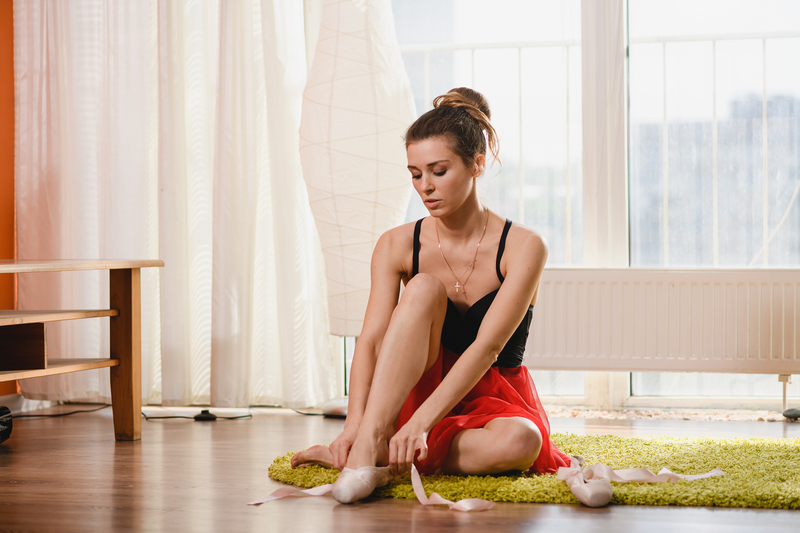A busy dancer’s day can consist of moving studio to studio — to take class, rehearse, cross-train and audition. In a world of mandated social distancing, however, dancers are moving from room to room in their home. For now, we also don’t have the structured systems that kept us dancing hard day by day. How’s a dancer to stay at the top of their technique, artistry and fitness level? With resourcefulness, commitment and adaptability, it’s possible.
At one level, the dance community has come together in a wonderful way in the face of the world’s current challenges. We can each benefit from, as well as contribute to, that fruitful unity. At another, it’s up to each of us to make the most of this time for ourselves — as movers, artists and people. When we can finally dance in studios and on stages together again, we’ll all be the better for it.
#1. Create your own training schedule.
Even with nearly incalculable cancellations (classes, performances, auditions, rehearsals), a wonderful thing about the dance world in the time of COVID-19 is how teachers in all sorts of dance styles are offering pay-what-you-can or low-cost classes online — over Instagram Live, Facebook Live, Vimeo, Zoom and YouTube. Research if your favorite teachers and companies are offering these sorts of classes, and write down the times and internet platform. Try to include all of the styles that you typically take and ensure that there aren’t schedule conflicts.
Get all of that down in your calendar, and then all there is left to do is dance! Do the same with cross-training. YouTube has great classes in Pilates, yoga and other fitness forms that are beneficial and enjoyable for dancers (and note any potential schedule conflicts with your technique classes). If you can’t find cross-training that resonates with you, design your own cross-training sessions for yourself. Running and power-walking outside are also options, so long as you stay at least six feet from others. If one is accessible to you, wear a mask as well.
Online classes don’t resonate with all dancers. If that’s you, design your own classes and cross-training sessions. Give yourself a ballet barre, do some favorite center exercises, improv to some music that inspires you to move. Are there pieces you’ve rehearsed that are still in your body that you could run for yourself? Take time to get into the nuances. Explore! Perhaps create some phrases. In this approach, the challenge is the lack of someone to push you to give your all. The advantage is freedom to dance and hone your technique and artistry — in your own way and on your own time.
#2. Find an “accountability” buddy.
With a self-designed home training program, there’s no one to see whether or not you show up to class (with the exception of Zoom classes). So, make it so there’s someone who knows if you show up. Ask a dance friend if they’ll be “accountability buddies” with you. If that person can’t or is not interested, for whatever reason, try another dance friend. When you find that person, share your dance schedules, and commit to stick to what you’ve shared with each other.
More informally, be on an “honor system” and share with each other how you’ve been doing with class. Beyond showing up, are you giving your all? Have you made any breakthroughs, or are you struggling technically? Check in by phone, video chat, or chat through another social media platform. Discuss how you’re doing in your creative lives — and, if you need personal support, perhaps your accountability buddy can offer that as well. “Social distancing” does not mean that we have to cut off social ties; some have proposed “physical distancing” as a better alternative.
#3. If things go off track, adapt.
Like with any self-improvement program or accountability system, things could get off track — such as if you miss a class, if a class changes time and you can no longer take it, or the like. If and when that happens, it doesn’t mean that your plan is done. Just take an extra class the next day, or give yourself one, if at all possible. If you miss one class, it won’t be any big deal in the long run. If a class changes time, find another class in the same style that works for you, if possible. The world as it currently is requires adaptation and flexibility from all of us. Thankfully, dancers are particularly adaptable and flexible — and are now demonstrating that yet again.
#4. Take time to enrich your artistry and discover new things.
Arguably, dance artistry is as much about bringing life experience to movement as it is about technique. Growth as a dancer can occur when not dancing at all. This time in quarantine offers us a potentially once-in-a-lifetime chance to work on our creative, professional, and personal lives — by reading, reflecting, journaling, meditating, and the like. Looping back to training, reading about artists or organizations that you admire, leadership, or other things that uplift you can inspire you to work harder than ever — even in this time of being physically apart from dance friends and colleagues, and such pervasive uncertainty. You could even learn about creative problem-solving approaches that you could call upon, including issues you might be experiencing with maintaining your training.
Journaling and reflecting can be intriguing, illuminating, and creatively fruitful. Finding expression in other art forms can bring similar effects. Paint, sing, or write a poem, and see what happens. Be intentional about staying connected with loved ones, and see what that can bring. We can make the best of this time. It hasn’t been, and won’t be, easy. Luckily enough, dancers are used to doing hard things. Let’s keep dancing!
By Kathryn Boland of Dance Informa.













